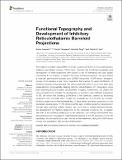| dc.contributor.author | Imaizumi, Kazuo | |
| dc.contributor.author | Yanagawa, Yuchio | |
| dc.contributor.author | Feng, Guoping | |
| dc.contributor.author | Lee, Charles C. | |
| dc.date.accessioned | 2019-03-26T17:15:42Z | |
| dc.date.available | 2019-03-26T17:15:42Z | |
| dc.date.issued | 2018-10 | |
| dc.identifier.issn | 1662-5129 | |
| dc.identifier.uri | http://hdl.handle.net/1721.1/121108 | |
| dc.description.abstract | The thalamic reticular nucleus (TRN) is the main source of inhibition to the somatosensory thalamus (ventrobasal nucleus, VB) in mice. However, the functional topography and development of these projections with respect to the VB barreloids has been largely unexplored. In this respect, to assist in the study of these projections, we have utilized a vesicular gamma-aminobutryic acid (GABA) transporter (VGAT)-Venus transgenic mouse line to develop a brain slice preparation that enables the rapid identification of inhibitory neurons and projections. We demonstrate the utility of our in vitro brain slice preparation for physiologically mapping inhibitory reticulothalamic (RT) topography, using laser-scanning photostimulation via glutamate uncaging. Furthermore, we utilized this slice preparation to compare the development of excitatory and inhibitory projections to VB. We found that excitatory projections to the barreloids, created by ascending projections from the brain stem, develop by postnatal day 2–3 (P2–P3). By contrast, inhibitory projections to the barreloids lag ~5 days behind excitatory projections to the barreloids, developing by P7–P8. We probed this lag in inhibitory projection development through early postnatal whisker lesions. We found that in whisker-lesioned animals, the development of inhibitory projections to the barreloids closed by P4, in register with that of the excitatory projections to the barreloids. Our findings demonstrate both developmental and topographic organizational features of the RT projection to the VB barreloids, whose mechanisms can now be further examined utilizing the VGAT-Venus mouse slice preparation that we have characterized. | en_US |
| dc.description.sponsorship | SVM CORP (Grant LAV 3487) | en_US |
| dc.publisher | Frontiers Research Foundation | en_US |
| dc.relation.isversionof | http://dx.doi.org/10.3389/fnana.2018.00087 | en_US |
| dc.rights | Creative Commons Attribution 4.0 International license | en_US |
| dc.rights.uri | https://creativecommons.org/licenses/by/4.0/ | en_US |
| dc.source | Frontiers | en_US |
| dc.title | Functional Topography and Development of Inhibitory Reticulothalamic Barreloid Projections | en_US |
| dc.type | Article | en_US |
| dc.identifier.citation | Imaizumi, Kazuo, Yuchio Yanagawa, Guoping Feng, and Charles C. Lee. “Functional Topography and Development of Inhibitory Reticulothalamic Barreloid Projections.” Frontiers in Neuroanatomy 12 (October 31, 2018). © 2018 Imaizumi, Yanagawa, Feng and Lee. | en_US |
| dc.contributor.department | Massachusetts Institute of Technology. Department of Brain and Cognitive Sciences | en_US |
| dc.contributor.department | McGovern Institute for Brain Research at MIT | en_US |
| dc.contributor.mitauthor | Imaizumi, Kazuo | |
| dc.contributor.mitauthor | Feng, Guoping | |
| dc.relation.journal | Frontiers in Neuroanatomy | en_US |
| dc.eprint.version | Final published version | en_US |
| dc.type.uri | http://purl.org/eprint/type/JournalArticle | en_US |
| eprint.status | http://purl.org/eprint/status/PeerReviewed | en_US |
| dc.date.updated | 2019-02-28T14:12:43Z | |
| dspace.orderedauthors | Imaizumi, Kazuo; Yanagawa, Yuchio; Feng, Guoping; Lee, Charles C. | en_US |
| dspace.embargo.terms | N | en_US |
| dc.identifier.orcid | https://orcid.org/0000-0001-7165-9978 | |
| dc.identifier.orcid | https://orcid.org/0000-0002-8021-277X | |
| mit.license | PUBLISHER_CC | en_US |
